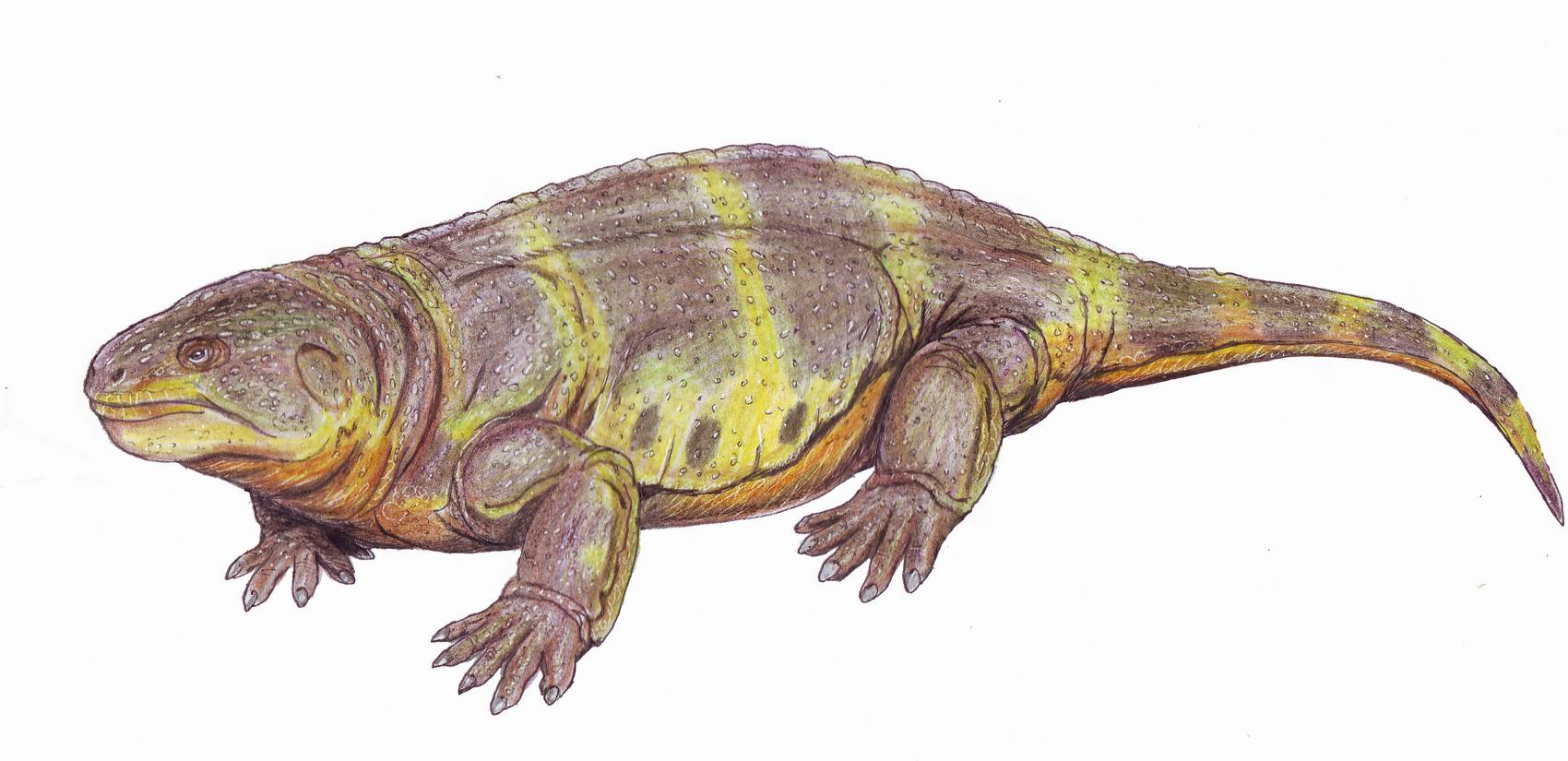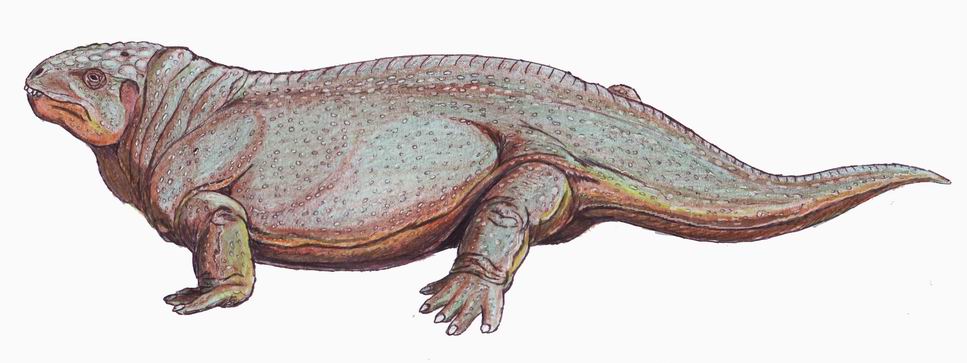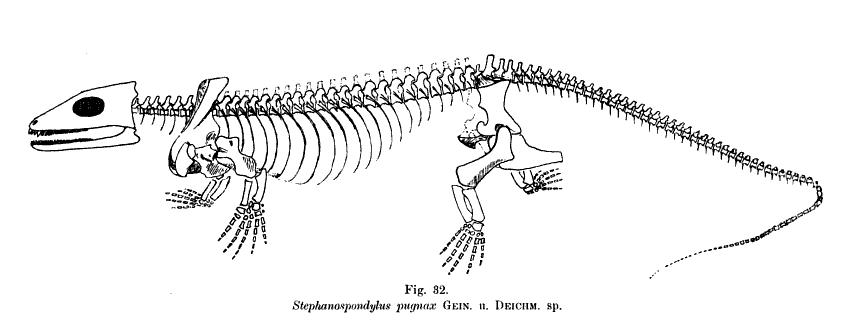|
Diadectids
Diadectidae is an extinct family (biology), family of early tetrapods that lived in what is now North America and Europe during the Late Carboniferous and Early Permian in Asia during the Late Permian. They were the first herbivore, herbivorous tetrapods, and also the first fully terrestrial animals to attain large sizes. Footprints indicate that diadectids walked with an erect posture. They were the first to exploit plant material in terrestrial food chains, making their appearance an important stage in both vertebrate evolution and the development of terrestrial ecosystems. The best known and largest representative of the family is ''Diadectes'', a heavily built animal that attained a maximum length of several metres. Several other genera and various fragmentary fossil remains are also known. Although well known genera like ''Diadectes'' first appear in the Late Pennsylvanian, fragmentary remains of possible diadectids are known from much earlier deposits, including a piece of l ... [...More Info...] [...Related Items...] OR: [Wikipedia] [Google] [Baidu] |
Ambedus
''Ambedus'' is an extinct genus of possible diadectid reptiliomorph. Fossils have been found from the Early Permian Dunkard Group of Monroe County, Ohio, Monroe County, Ohio. The type species ''A. pusillus'' was named in 2004. The genus name comes from the Latin word ''ambedo'' meaning "to nibble", in reference to its herbivorous diet. The specific name ''pusillus'' means "tiny" in Latin. Description ''Ambedus'' is a small tetrapod, possible Diadectid, known only from maxillae and dentary bones. It is usually considered the most primitive diadectid because unlike other forms it had a small, shallow lower jaw and many simple, conical teeth. It was also smaller than the later, rather bulky diadectids. Later diadectids have deep jaws with few teeth and forward-projecting incisor, incisiforms at the tips of the jaws for consuming plant material, and a corresponding greater girth. David Berman's 2013 paper argued against the inclusion of Ambedus in Diadectidae, for several reasons. He ... [...More Info...] [...Related Items...] OR: [Wikipedia] [Google] [Baidu] |
Alveusdectes
''Alveusdectes'' is an extinct genus of diadectid tetrapod (represented by the type species ''Alveusdectes fenestralis'') from the Late Permian of China. Like other diadectids, it was a large-bodied terrestrial herbivore capable of eating tough fibrous plant material. It was described in 2015 on the basis of a single partial skull and lower jaw found in the Shangshihezi Formation near the city of Jiyuan in Henan. This skull was found in a layer of the Shangshihezi Formation that dates to about 256 million years ago and contains the remains of many other terrestrial tetrapods including pareiasaurs, chroniosuchians, and therapsids. ''Alveusdectes'' is the youngest known diadectid by 16 million years and is also the only diadectid known from Asia. It likely represents a late-surviving lineage of diadectids that radiated eastward from western Laurasia (modern-day North America and Europe) into north China. Diadectids are otherwise absent from eastern Laurasia, which may reflect their ... [...More Info...] [...Related Items...] OR: [Wikipedia] [Google] [Baidu] |
Diasparactus
''Diasparactus'' is an extinct genus of diadectid reptiliomorphs, a group quite closely related to the amniotes, and paralleling some of their features. Like all advanced diadectids, ''Diasparactus'' was a herbivore, though not as large as its more well known relative ''Diadectes''. In ''Diasparactus'', the spines of the dorsal vertebrae are higher than in other genera in the family.A Description of a nearly complete skeleton of ''Diasparactus zenos'' Case Permo-Carboniferous Vertebrates from New Mexico, p17-35. Retrieved 2011-09-11. History  In 1910, E. C. Ca ...
In 1910, E. C. Ca ...
[...More Info...] [...Related Items...] OR: [Wikipedia] [Google] [Baidu] |
Phanerosaurus
''Phanerosaurus'' is an extinct genus of diadectid reptiliomorph from the Early Permian of Germany. Fossils are known from the Leukersdorf Formation near Zwickau. German paleontologist Christian Erich Hermann von Meyer named the type species ''P. naumanni'' in 1860 on the basis of several sacral and presacral vertebrae. A second species, ''P. pungnax'', was named in 1882 but placed in its own genus ''Stephanospondylus'' in 1905. Description Like those of other diadectids, the vertebrae of ''Phanerosaurus'' are very wide. The neural arches are very tall and extend beyond the centra with prominent zygapophyses projecting from either side. There are few distinctive features in the vertebrae of ''Phanerosaurus'' to distinguish it from other diadectids. One of the only unique characteristics are its shortened neural spine The spinal column, a defining synapomorphy shared by nearly all vertebrates,Hagfish are believed to have secondarily lost their spinal column is a moderately f ... [...More Info...] [...Related Items...] OR: [Wikipedia] [Google] [Baidu] |
Diadectes
''Diadectes'' (meaning ''crosswise-biter'') is an extinct genus of large reptiliomorphs or synapsids that lived during the early Permian period (Artinskian-Kungurian stages of the Cisuralian epoch, between 290 and 272 million years ago). ''Diadectes'' was one of the first herbivorous tetrapods, and also one of the first fully terrestrial vertebrates to attain large size. Description ''Diadectes'' was a heavily built animal, up to long, with a thick-boned skull, heavy vertebrae and ribs, massive limb girdles, and short, robust limbs. The nature of the limbs and vertebrae clearly indicates a terrestrial animal. The rib cage was assumed to be barrel-shaped, but new fossils show the ribs were actually sticking out to the sides. Paleobiology It possesses some characteristics of reptilians and amphibians, combining a reptile-like skeleton with a more primitive, seymouriamorph-like skull. ''Diadectes'' has been classified as belonging to the sister group of the amniotes. Among ... [...More Info...] [...Related Items...] OR: [Wikipedia] [Google] [Baidu] |
Desmatodon
''Desmatodon'' is an extinct genus of diadectid reptiliomorph. With fossils found from the Kasimovian (Missourian) stage of the Late Carboniferous of Pennsylvania, Colorado, and New Mexico in the United States, ''Desmatodon'' is the oldest known diadectid. Two species are currently recognized: the type species ''D. hollandi'' and the species ''D. hesperis''. Description Remains of ''Desmatodon'' have been found from the Glenshaw Formation of Pennsylvania, the Sangre de Cristo Formation in Colorado, and the Cutler Formation The Cutler Formation or Cutler Group is a rock unit that is exposed across the U.S. states of Arizona, northwest New Mexico, southeast Utah and southwest Colorado. It was laid down in the Early Permian during the Wolfcampian epoch. Descript ... of New Mexico. The genus is known mostly from teeth and portions of skulls. The cheek teeth are robust and spade-shaped with several cusps on their surfaces. The two species can be distinguished by the distribu ... [...More Info...] [...Related Items...] OR: [Wikipedia] [Google] [Baidu] |
Stephanospondylus
''Stephanospondylus'' is an extinct genus of diadectid reptiliomorph from the Early Permian of Germany. Fossils have been found in deposits of the Lower Rotliegend near Dresden. The type species ''S. pugnax'' was originally referred to the genus ''Phanerosaurus'' in 1882 but was placed in its own genus in 1905. Description ''Stephanospondylus'' is known only from several vertebrae and fragments of the upper and lower jaws. It was named in 1882 on the basis of two slabs, the fossils in which were thought to represent two individuals. With the erection of a new genus in 1905, the fossils were considered to be part of a single individual. In 1925, Alfred Romer determined that only parts of the jaws and some vertebrae belonged to ''Stephanospondylus''; the other material belonged to the temnospondyl amphibian ''Onchiodon''. ''Stephanospondylus'' has spade-shaped teeth adapted to cutting plant material. The vertebrae are distinct from those of other diadectids in that they lack hyp ... [...More Info...] [...Related Items...] OR: [Wikipedia] [Google] [Baidu] |
Oradectes
''Oradectes'' (meaning "margin biter", from Latin ''ora'' (margin) and ''dectes'' (biter)) is an extinct genus of diadectid reptiliomorph. It is known from a single partial skeleton collected from the Early Permian Cutler Formation of Colorado in the United States. The type species, ''O. sanmiguelensis'', was originally named as a species of ''Diadectes'' in 1965. It was given its own genus in 2010. Description The only material belonging to ''Oradectes'' is a partial skeleton known as MCZ 2989. This skeleton includes a complete skull, neck vertebrae, a partial pectoral girdle, the right forelimb, and some ribs. The skull is robust with spade-shaped teeth lining the jaws. The front teeth of the lower jaw protrude outward. A ventral border of the Meckelian fenestra of the lower jaw formed entirely from the splenial bone is a distinguishing feature of ''Oradectes'' found in no other diadectid. Classification ''Oradectes sanmiguelensis'' was described by Lewis and Vaughn (1965) as ... [...More Info...] [...Related Items...] OR: [Wikipedia] [Google] [Baidu] |
Orobates
''Orobates'' is an extinct genus of diadectid reptiliomorphs that lived during the Early Permian. Its fossilised remains were found in Germany. A combination of primitive and derived traits (i.e. autapomorphic and plesiomorphic) distinguish it from all other well-known members of Diadectidae, a family of herbivorous reptiliomorphs. It weighed about 4 kg and appears to have been part of an upland fauna, browsing on high fibre plants. Locomotion The trace fossil species ''Ichniotherium sphaerodactylum'', from Bromacker in Germany, has been attributed to ''Orobates''. A study in 2015 found that the genus was characterized by a long body and tail, with fairly short legs and a short skull compared to the more derived ''Diadectes''. This indicates ''Orobates'' was less specialised for long treks compared to ''Diadectes''. A three-dimensional digital reconstruction of the holotype specimen allowed further analysis of the postcranium. An analysis of the mobility of the hip joi ... [...More Info...] [...Related Items...] OR: [Wikipedia] [Google] [Baidu] |
Ecosystem
An ecosystem (or ecological system) consists of all the organisms and the physical environment with which they interact. These biotic and abiotic components are linked together through nutrient cycles and energy flows. Energy enters the system through photosynthesis and is incorporated into plant tissue. By feeding on plants and on one another, animals play an important role in the movement of matter and energy through the system. They also influence the quantity of plant and microbial biomass present. By breaking down dead organic matter, decomposers release carbon back to the atmosphere and facilitate nutrient cycling by converting nutrients stored in dead biomass back to a form that can be readily used by plants and microbes. Ecosystems are controlled by external and internal factors. External factors such as climate, parent material which forms the soil and topography, control the overall structure of an ecosystem but are not themselves influenced by the ecosystem. ... [...More Info...] [...Related Items...] OR: [Wikipedia] [Google] [Baidu] |
Genera
Genus ( plural genera ) is a taxonomic rank used in the biological classification of living and fossil organisms as well as viruses. In the hierarchy of biological classification, genus comes above species and below family. In binomial nomenclature, the genus name forms the first part of the binomial species name for each species within the genus. :E.g. ''Panthera leo'' (lion) and ''Panthera onca'' (jaguar) are two species within the genus '' Panthera''. ''Panthera'' is a genus within the family Felidae. The composition of a genus is determined by taxonomists. The standards for genus classification are not strictly codified, so different authorities often produce different classifications for genera. There are some general practices used, however, including the idea that a newly defined genus should fulfill these three criteria to be descriptively useful: # monophyly – all descendants of an ancestral taxon are grouped together (i.e. phylogenetic analysis should clearly demons ... [...More Info...] [...Related Items...] OR: [Wikipedia] [Google] [Baidu] |
Fossil
A fossil (from Classical Latin , ) is any preserved remains, impression, or trace of any once-living thing from a past geological age. Examples include bones, shells, exoskeletons, stone imprints of animals or microbes, objects preserved in amber, hair, petrified wood and DNA remnants. The totality of fossils is known as the ''fossil record''. Paleontology is the study of fossils: their age, method of formation, and evolutionary significance. Specimens are usually considered to be fossils if they are over 10,000 years old. The oldest fossils are around 3.48 billion years old to 4.1 billion years old. Early edition, published online before print. The observation in the 19th century that certain fossils were associated with certain rock strata led to the recognition of a geological timescale and the relative ages of different fossils. The development of radiometric dating techniques in the early 20th century allowed scientists to quantitatively measure the ... [...More Info...] [...Related Items...] OR: [Wikipedia] [Google] [Baidu] |






